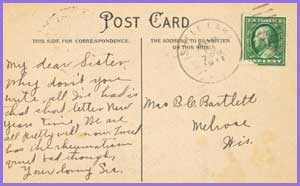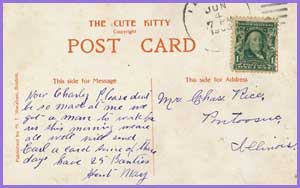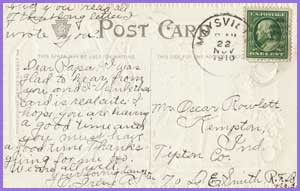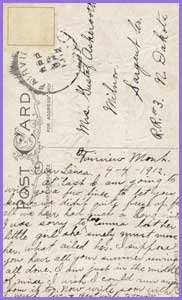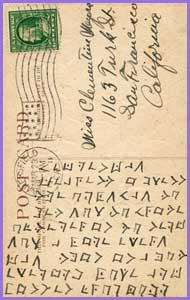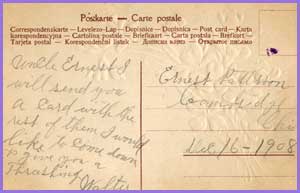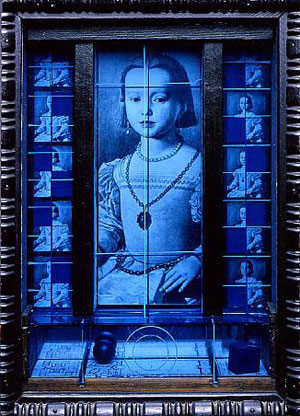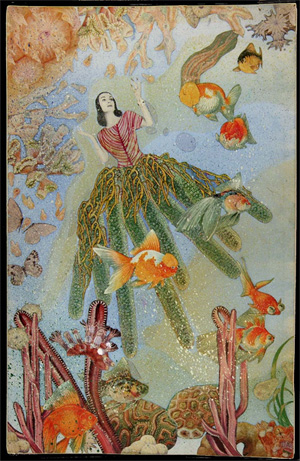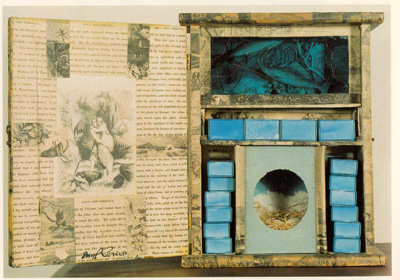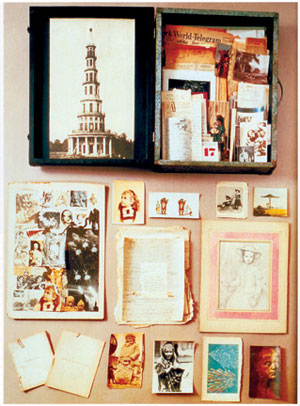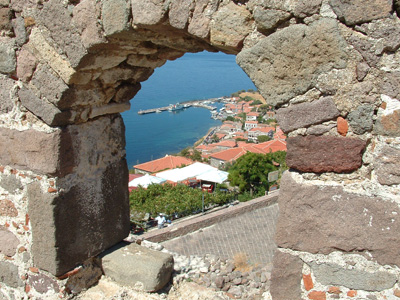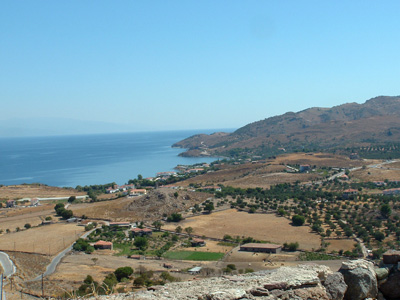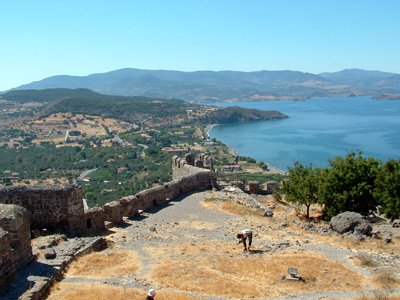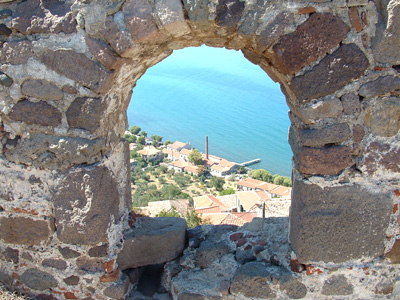I love old postcards. Not just because of the variety of art work on the front, but also because of the little treasures of text on the back. I love looking at what people have written, seeing where the cards were postmarked, where they traveled to. I like looking at the stamps, and the way the words “Post Card” are written. I love to see the way people spelled words and the appearance of their handwriting. So I decided to share with you some little gems from my collection.
It’s amazing how much information people could squeeze on the back of one half of a 3 X 5 inch postcard. And almost without an exception, they’re all written in cursive. In fact, if you think about it, postcards are really the handwritten equivalent to text messaging. There are little spelling shortcuts, the grammar is horrible but understandable, and getting to the point is of the utmost importance.
Below you’ll find scans of the postcard backs. If you click on the pictures, they’ll open up in a larger window. Beneath each thumbnail, I typed out the text to the best of my ability. If something was undecipherable, I put a question mark in its place.
I hope you’ll enjoy reading these as much as I do. They reveal a lot about the people and times, in some cases, of almost one hundred years ago.
To Mrs. BC. Bartlett
Melrose, Wisconsin
My Dear Sister,
Why don’t you write, all I’ve had is that short letter new years time. We are all pretty well now. Jared (?) has the rheumatism quiet (quite?) bad though.
Your loving Sis.
Shell Lake
April 13, 1911
To Miss M.N. Sullivan
Pacific Gas and Elec Co.
518 13th St.
Oakland, Cal
Dearest Auntie,
Here I am in De Sabla. Went fishing last night with Willis. He is a cute kid. He caught 5 and me 0. Listen dearie will you do something for me? I broke my little barette and my bob is awful. Can you get me one and send it to me as soon as possible. Any kind 50 cents at Maymonts (?) will be great. I’ll pay you when I get home or chg (charge?) to me. Will write today.
Love to all,
Mame
1922
Cal
To Irene Howlett
Parkville, Mich.
St. Joe Co.
Dear Cousin,
This in haste. We are marketing our Pears and Potatoes now. We had a fine fall. You remember the doily I was working on or finished when we was at your place. Well I have eight to make like six before xmas tow (two?) after. I will have to make my fingers go. Addie adress is 2098 E 93 St. Chevel and ? Sarah. Put our B.D. 33 on my mail. Will get it sooner as there are many Lorvers (?) in Barberton.
Nov 3, 1914
Barberton, Ohio
To Miss Mary C. Lenig
Ickesburg, Pa.
Well Mary, was disiappointed again. This morning Harry was watching for you. Have you got the mumps yet? Wesley has them and Serilda. Thomas thinks he is getting them & he is ordering fish. Don’t know how he will distribute them. Your Pa & Ma was to Markleville yesterday. StellaNoll and her mother started for the west this morning. Aunt Harriet T. fell on Sat. & nearly broke her nose. You ought to see her . . her face is as black as a stove. Her nose is like a rainbarrel. Ha. Ha. Dont laught. Shell (?) said you diden’t get up in time to go along this morning. Harry is crying to go to Gammas(?).
From Mary
April 4, 1910
Wila, PA
To Mrs. Anna Smith
Woodland, Mich
Hellow anna
John & Clara B. hope you are all well. Marian is about the same not able to do any thing.
love to all.
Ruland
Feb. 19, 1917
Fort Recovery, Ohio
To Miss Florence Shafer
Sparta, Wis.
329 North L. St.
c/0 C. W. Hubbard
Dear Sister Florence:
I will send you an Easter card to remind you of next sunday. I don’t think I will come down saturday. I can’t stay down at nite. If I do come . but don’t think you will see me this saturday. You want to know how you are going to Catarrah(?). I just can’t wait until I can get down town to stay, but I won’t stay in this town very long. I got Mamies letters yesterday. I didn’t go over to help her wash this week. I guess it made her mad becasue I wouldn’t get out of the wash tub monday and go over and help her but I don’t care about scrubbing her old carpets and how so you see it dont hurt me. I couldn’t work around that mut any how. Answer Soon. I am same as B/4.
Your Loving Sister M.E. S.
I have sent 7 Easter cards and another one besides. Home (?) writing today.
April 19, ’16
Sparta, Wis
To Mr. Chas Rice
Pontoosuc, Illinois
Now Charle Please don’t be so mad at me we got a man to work for us this morning we are all well will send Earl a card some of thse days have 25 Banties
Aunt May
June 4, 1908 (?)
To Mrs Ora Wickett
New Virginia, Iowa
R.F.D. #
Mrs Wickett,
I think the 26 is your birthday am I right about it? Just thot I’d remind you of it and wish you many more such days. how is baby Ashton our baby Raymond is doing fine. I haven’t any little chickens yet & only 6 hens setting, have some garden made come over & stay all day all of you. With best wishes your friend Ella Kimmer (?)
April 24, 1909
New Virginia, Iowa
To Oscar Rowlett
Kempton, Ind.
Tipton Co.
Did you read all of that long letter I wrote you?
Dear Papa: I was glad to hear from you and I think that card is real cute. I hope you are having a good time and you must have a good time. Thanks– giving for me too. We are all well.
Your loving daughter,
O. Irene R.
70 D.E. Smith
R.F.B. No. 2
Nov 22, 1910
Maysville, [Indiana]
To Mrs. Mae Thompson
Samoa, Cal
Dear Mae
How are you when you come out we will play you the song silver bell. Ruth got from Anita (?). It for the phonograph. It is a dandy.
Dec. 12, 1910
??tuna, Cal
To Mrs. Gustaf Asherooth
Milnor
Sargent Co (?)
R.R. #3
N. Dakota
Dear Laura.
At last I am going to write you a few lines to let you know we didn’t quite freeze up. for all we have (?) had such a long winter. I was sorry to hear Emma lost her little girl she surely must miss her. What ailed her. I suppose you have all your summer sewing all done. I am just in the middle of mine. I wish I could run away from it too. Now write soon.
With much love and Best wishes to you, Minnie
April 4, 1912
Fairview, Mont.
To Miss Cementine Meyers
1163 Turk St.
San Francisco, California
Can you decode it???
March 29, 1911
Bakersfield, Cal
To Ernest Patterson
[I can’t read the address]
Uncle Ernest
I will send you a card with the rest of them I would like to come down to give you a thrashing.
Walter
Dec. 16, 1908
